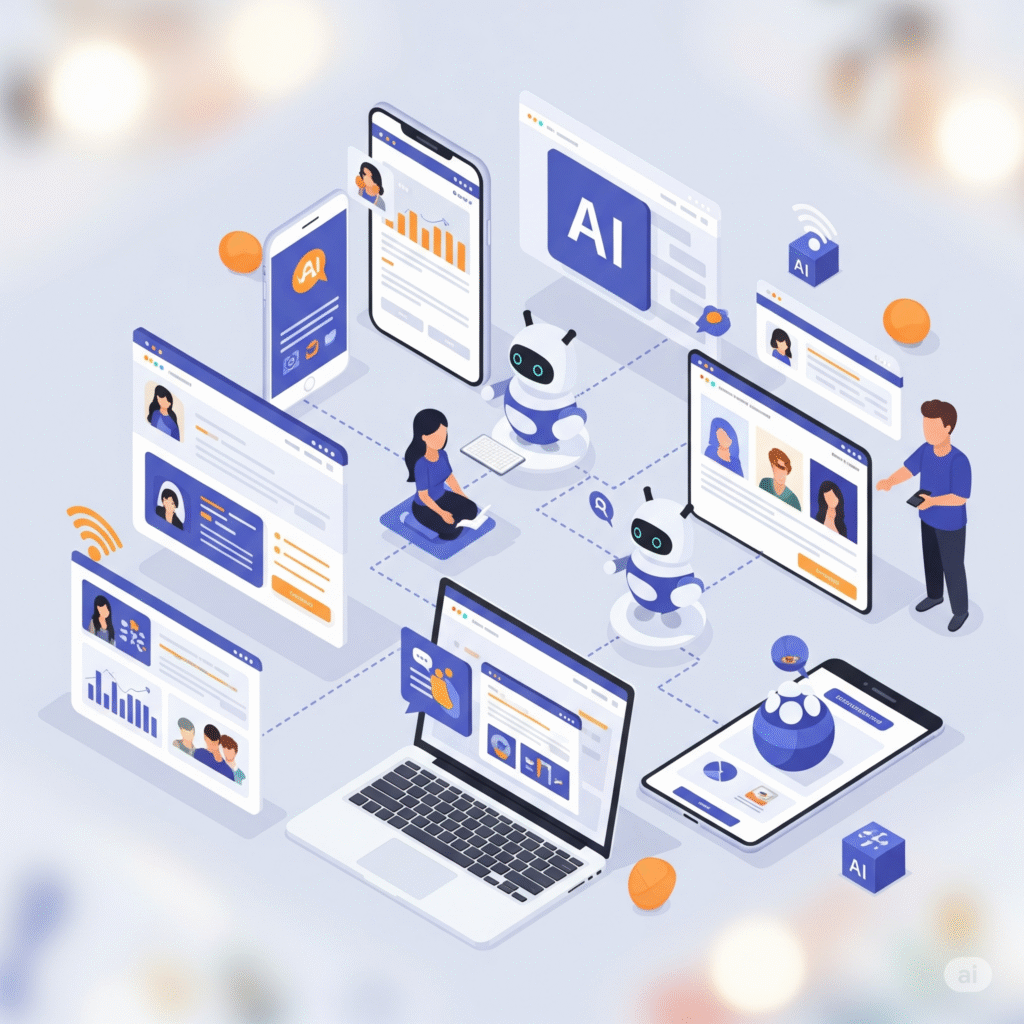Imagine this: Sarah, a passionate entrepreneur, pours her heart into her startup, crafting products with love and precision. Her days are filled with endless tasks—writing ad copy, scheduling social media posts, analyzing customer data, and tweaking campaigns. Yet, her sales stagnate. Her competitors, once equals, now dominate the market, their brands glowing on every digital corner. What’s their secret? Sarah’s missing the game-changer: AI-powered websites and apps for marketing. Without them, she’s fighting a losing battle, drowning in manual tasks while her rivals soar. This is the dramatic tale of what you’re losing if you don’t embrace AI—and how you can rewrite your story to triumph.

In a world where 72% of businesses leverage AI for marketing (McKinsey, 2024), ignoring these tools is like racing a Ferrari with a flat tire. This blog unveils the best AI websites and apps transforming product marketing, backed by real-world case studies, practical steps for daily use, and strategies to ensure your brand ranks high on Google. Follow this journey to unlock a future where your marketing thrives, not just survives.
The High Stakes of Modern Marketing: Why AI Is Non-Negotiable
Picture a battlefield: the digital marketplace. Every click, view, and purchase is a hard-won victory. Manual marketing—writing emails, guessing keywords, or manually tracking analytics—is a slow, grueling slog. Meanwhile, AI-powered tools are like elite warriors, automating tasks, predicting trends, and delivering personalized customer experiences at lightning speed. According to IBM, AI can save marketers 2.5 hours per day on repetitive tasks, freeing them for creative strategy. Without AI, you’re not just working harder—you’re falling behind.
Why You’re Losing Without AI
- Missed Personalization: 78% of consumers expect tailored experiences (Sprout Social, 2023). Manual efforts can’t match AI’s ability to analyze vast datasets and deliver hyper-personalized content.
- Wasted Time: Tasks like content creation and ad optimization take hours without automation, reducing your bandwidth for strategy.
- Lower ROI: AI-driven campaigns see up to 50% higher ROI (Salesforce, 2025) by targeting the right audiences with precision.
- Competitor Advantage: Brands using AI, like Netflix and Sephora, dominate engagement, leaving non-AI adopters in the dust.
This is the cost of inaction. But there’s hope. Let’s dive into the AI websites and apps that can transform your marketing, with real-world examples to prove their power.
Top AI Websites and Apps for Product Marketing
1. HubSpot: The All-in-One Marketing Maestro
What It Does: HubSpot’s AI-powered platform automates lead scoring, email campaigns, and content optimization, using machine learning to prioritize high-value prospects and personalize outreach.
Why It’s Essential: It streamlines workflows, boosts conversions, and aligns with Google’s E-E-A-T (Experience, Expertise, Authoritativeness, Trustworthiness) guidelines by delivering data-driven, customer-centric content.
Case Study: A small e-commerce startup used HubSpot’s AI to automate lead nurturing, analyzing user behavior to send targeted emails. Result? A 50% increase in qualified leads within six months (SmartOSC, 2024).
How to Use It: Integrate HubSpot with your CRM, set up automated email sequences, and use its AI-driven SEO tools to optimize blog content for keywords like “AI marketing tools.”
2. Sprout Social: The Social Media Sorcerer
What It Does: Sprout Social leverages AI to optimize social media scheduling, analyze engagement data, and recommend content strategies. Its sentiment analysis identifies customer emotions, ensuring timely responses.
Why It’s Essential: Social media drives 50% of online traffic for brands (Hightouch, 2024). Sprout’s AI maximizes visibility by posting at peak times, boosting engagement by up to 60% (SmartOSC, 2024).
Case Study: A retail brand used Sprout Social to schedule AI-optimized posts, resulting in a 60% increase in engagement rates and a 30% boost in click-throughs within three months.
How to Use It: Use Sprout’s AI to identify trending hashtags, schedule posts for maximum reach, and monitor brand sentiment to address customer feedback instantly.
3. Writesonic: The Content Creation Wizard
What It Does: Writesonic generates SEO-optimized blog posts, ad copy, and social media content by analyzing competitor data and inserting strategic keywords.
Why It’s Essential: Google prioritizes high-quality, relevant content. Writesonic ensures your content ranks by aligning with user intent and E-E-A-T standards.
Case Study: A tech startup used Writesonic to create 20 blog posts targeting “AI marketing tools,” increasing organic traffic by 200% in four months (X post by @AndrewBolis, 2025).
How to Use It: Input target keywords, let Writesonic generate drafts, and refine with human editing to maintain authenticity.
4. Invoca: The Conversion Intelligence Champion
What It Does: Invoca’s AI tracks call conversions, optimizes ad campaigns, and identifies high-performing keywords, reducing wasted ad spend.
Why It’s Essential: It bridges online and offline marketing, critical for businesses relying on phone sales. Invoca’s AI-driven insights cut costs and boost ROI.
Case Study: Rogers Communications used Invoca to optimize Google Ads, achieving an 82% decrease in cost per acquisition and an 18% increase in net revenue over two years (Invoca, 2024).
How to Use It: Integrate Invoca with Google Ads to track call conversions, eliminate low-performing keywords, and reallocate budgets to high-ROI campaigns.
5. Markopolo.ai: The Campaign Automation Alchemist
What It Does: Markopolo.ai automates marketing funnels, from audience targeting to content creation, using AI to optimize campaigns across platforms.
Why It’s Essential: It simplifies complex workflows, enabling small teams to compete with industry giants.
Case Study: A fashion brand used Markopolo.ai to automate ad campaigns, increasing conversions by 40% and reducing costs by 26% (Markopolo, 2024).
How to Use It: Set up a marketing funnel, let Markopolo analyze your audience, and deploy AI-generated ads tailored to user preferences.
The Tragic Cost of Ignoring AI: A Cautionary Tale
Meet Tom, Sarah’s competitor. While Sarah toiled manually, Tom embraced AI tools like HubSpot and Writesonic. His website ranks on Google’s first page for “product marketing solutions,” his social media posts go viral, and his email campaigns convert at triple Sarah’s rate. Tom’s secret? He automated repetitive tasks, used AI to personalize content, and optimized for SEO, leaving Sarah scrambling to catch up. By 2025, 78% of marketers will use AI for over 25% of their tasks (Markopolo, 2024). Without AI, you’re not just losing time—you’re losing customers, revenue, and relevance.
Steps to Integrate AI into Your Daily Marketing Routine
To avoid Sarah’s fate and emulate Tom’s success, follow these actionable steps to integrate AI into your daily marketing, ensuring efficiency, personalization, and Google rankings:
- Identify Pain Points (Day 1)
- Audit your marketing tasks. Are you spending hours on content creation, scheduling, or analytics?
- Example: If social media scheduling takes 10 hours weekly, tools like Sprout Social can cut this to 2 hours.
- Pro Tip: Use AI tools like ClickUp Brain to analyze workflows and pinpoint inefficiencies.
- Choose the Right AI Tools (Day 2-3)
- Select tools based on your needs: HubSpot for lead management, Writesonic for content, Invoca for ad optimization.
- Start with free trials to test compatibility.
- Case Study: A B2B startup used HubSpot’s free tier to automate email campaigns, boosting open rates by 31% (Salesforce, 2025).
- Optimize for SEO (Day 4-7)
- Use AI tools like Writesonic or HubSpot’s Breeze to identify high-intent keywords (e.g., “AI marketing apps,” “product marketing automation”).
- Create topic clusters with internal links to boost topical authority.
- Example: Workfellow’s AI-driven SEO strategy increased organic traffic by 2,200% (Workfellow Case Study, 2023).
- Automate Repetitive Tasks (Ongoing)
- Set up automated email sequences, social media schedules, and ad optimizations.
- Example: Sprout Social’s AI schedules posts at peak engagement times, saving 5 hours weekly (Sprout Social, 2023).
- Pro Tip: Use AI chatbots like Sephora’s to handle customer queries, reducing response time by 90% (Sembly AI, 2025).
- Monitor and Refine (Weekly)
- Use AI analytics (e.g., Invoca, HubSpot) to track campaign performance in real-time.
- Adjust strategies based on data-driven insights to maximize ROI.
- Case Study: Volkswagen used AI to optimize ad buying, cutting costs by 12% and boosting sales (Mailmodo, 2025).
The Dramatic Consequences of Delay
Every day you delay adopting AI, you lose ground. Your competitors are using tools like Markopolo.ai to automate funnels, Sprout Social to dominate social media, and Invoca to slash ad costs. By 2030, AI-driven marketing is projected to contribute $1.4-$2.6 trillion to global sales (McKinsey, 2024). Without AI, your brand risks fading into obscurity, buried under a flood of smarter, faster campaigns.
A Day in the Life with AI: Your Path to Healthy Marketing
Imagine waking up to a dashboard where HubSpot has scored your leads, Sprout Social has scheduled your posts, and Writesonic has drafted a blog ranking for “AI marketing tools.” Your tasks? Review AI-generated content, tweak strategies based on real-time analytics, and focus on creative campaigns. This is healthy marketing: efficient, data-driven, and customer-centric. Here’s how to make it your reality:
- Morning: Check AI analytics for campaign performance. Adjust ad bids using Invoca’s insights.
- Midday: Use Writesonic to draft SEO-optimized content, ensuring alignment with E-E-A-T.
- Afternoon: Monitor social media sentiment with Sprout Social, responding to customer feedback.
- Evening: Review automated email performance in HubSpot, refining for higher open rates.
Conclusion: Rewrite Your Marketing Destiny
Sarah’s story doesn’t have to be yours. By embracing AI websites and apps like HubSpot, Sprout Social, Writesonic, Invoca, and Markopolo.ai, you can automate tasks, personalize experiences, and dominate Google rankings. The evidence is clear: brands using AI see 50% higher conversions, 60% better engagement, and hours saved daily. Don’t let your competitors write your ending. Act now—integrate AI, optimize for SEO, and transform your marketing into a powerhouse of efficiency and impact.
Start your AI journey today. Try HubSpot’s free tier, test Writesonic for content creation, or schedule a Markopolo.ai demo. Your brand’s future depends on it.
Disclaimer
The information in this blog is based on credible sources and real-world case studies as of June 2025. While we strive for accuracy, results from AI tools vary based on implementation, industry, and audience. Always consult with marketing professionals and verify AI outputs for accuracy and brand alignment. The author is not liable for any losses or damages resulting from the use of these tools. For the latest pricing and features, visit the respective platforms (e.g., HubSpot, Sprout Social, Writesonic).


